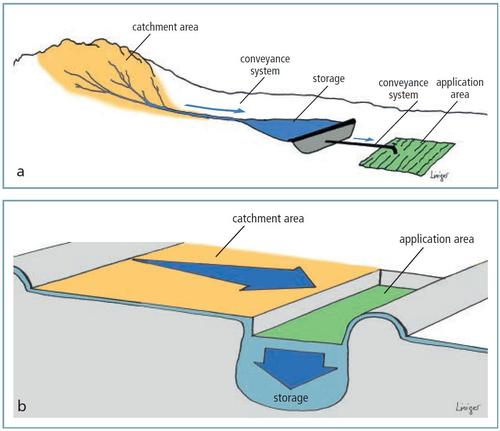Principle, concept and components
Water harvesting (WH) must be seen as an integral part of sustainable land (and water) management. The basic principle of water harvesting is to capture precipitation falling in one area and transfer it to another, thereby increasing the amount of water available in the latter. The basic components of a water harvesting system are a catchment or collection area, the runoff conveyance system, a storage component and an application area. In some cases, the components are adjacent to each other, in other cases they are connected by a conveyance system. The storage and application areas may also be the same, typically where water is concentrated in the soil for direct use by plants.
- Catchment or collection area: this is where rain in the form of runoff is harvested. The catchment may be as small as a few square meters or as large as several square kilometers. It may be a rooftop, a paved road, compacted surfaces, rocky areas or open rangelands, cultivated or uncultivated land and natural slopes.
- Conveyance system: this is where runoff is conveyed through gutters, pipes (in case of rooftop WH) or overland, rill, gully or channel flow and either diverted onto cultivated fields (where water is stored in the soil) or into specifically designed storage facilities.
- Storage component: this is where harvested runoff water is stored until it is used by people, animals or plants. Water may be stored in the soil profile as soil moisture, or above ground (jars, ponds or reservoirs), or underground (cisterns) or as groundwater (near-surface aquifers). There, where concentrated runoff is directly diverted to fields, the application area is identical to the storage area, as plants can directly use the accumulated soil water. A great variety of designed storage systems keep the water until it is used either adjacent to the storage facilities or further away.
- Application area or target: this is where the harvested water is put into use either for domestic consumption (drinking and other household uses), for livestock consumption, or agricultural use (including supplementary irrigation).
(Mekdaschi & Liniger 2013)
